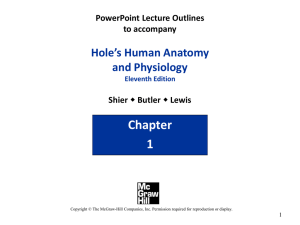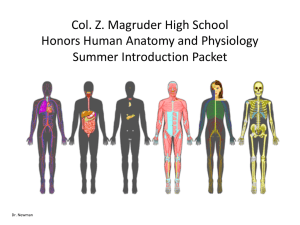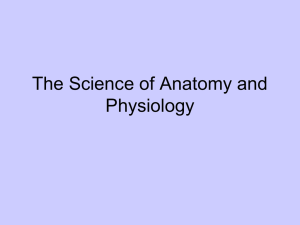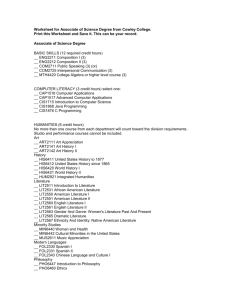Introduction to anatomy and physiology
advertisement
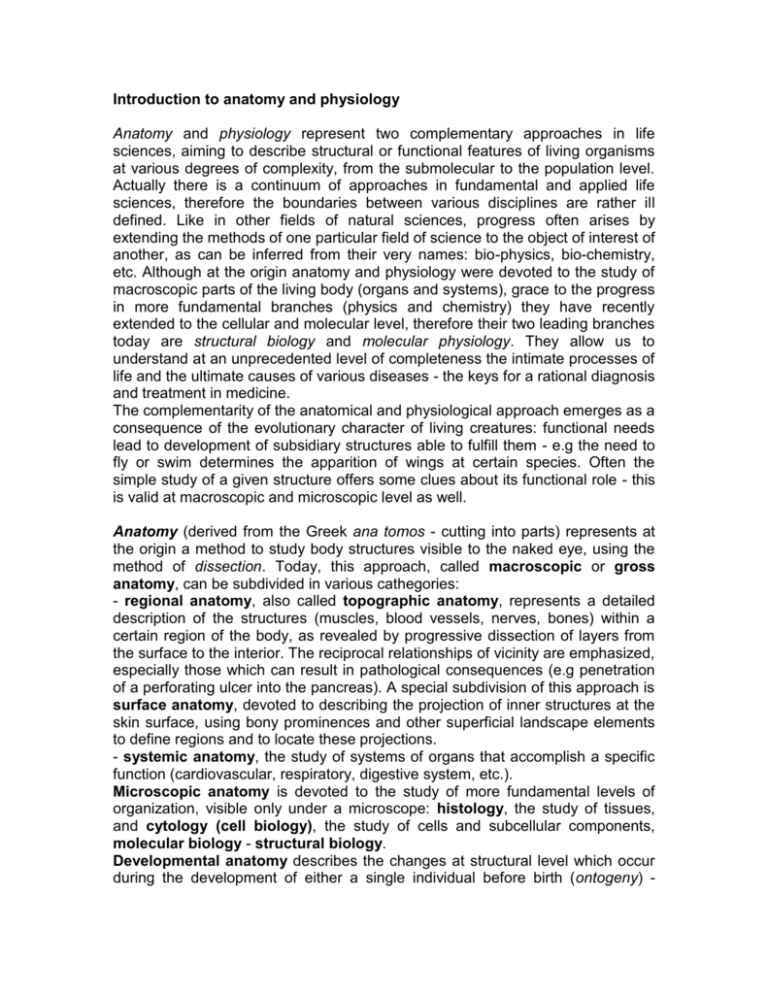
Introduction to anatomy and physiology Anatomy and physiology represent two complementary approaches in life sciences, aiming to describe structural or functional features of living organisms at various degrees of complexity, from the submolecular to the population level. Actually there is a continuum of approaches in fundamental and applied life sciences, therefore the boundaries between various disciplines are rather ill defined. Like in other fields of natural sciences, progress often arises by extending the methods of one particular field of science to the object of interest of another, as can be inferred from their very names: bio-physics, bio-chemistry, etc. Although at the origin anatomy and physiology were devoted to the study of macroscopic parts of the living body (organs and systems), grace to the progress in more fundamental branches (physics and chemistry) they have recently extended to the cellular and molecular level, therefore their two leading branches today are structural biology and molecular physiology. They allow us to understand at an unprecedented level of completeness the intimate processes of life and the ultimate causes of various diseases - the keys for a rational diagnosis and treatment in medicine. The complementarity of the anatomical and physiological approach emerges as a consequence of the evolutionary character of living creatures: functional needs lead to development of subsidiary structures able to fulfill them - e.g the need to fly or swim determines the apparition of wings at certain species. Often the simple study of a given structure offers some clues about its functional role - this is valid at macroscopic and microscopic level as well. Anatomy (derived from the Greek ana tomos - cutting into parts) represents at the origin a method to study body structures visible to the naked eye, using the method of dissection. Today, this approach, called macroscopic or gross anatomy, can be subdivided in various cathegories: - regional anatomy, also called topographic anatomy, represents a detailed description of the structures (muscles, blood vessels, nerves, bones) within a certain region of the body, as revealed by progressive dissection of layers from the surface to the interior. The reciprocal relationships of vicinity are emphasized, especially those which can result in pathological consequences (e.g penetration of a perforating ulcer into the pancreas). A special subdivision of this approach is surface anatomy, devoted to describing the projection of inner structures at the skin surface, using bony prominences and other superficial landscape elements to define regions and to locate these projections. - systemic anatomy, the study of systems of organs that accomplish a specific function (cardiovascular, respiratory, digestive system, etc.). Microscopic anatomy is devoted to the study of more fundamental levels of organization, visible only under a microscope: histology, the study of tissues, and cytology (cell biology), the study of cells and subcellular components, molecular biology - structural biology. Developmental anatomy describes the changes at structural level which occur during the development of either a single individual before birth (ontogeny) - embryology, or during the evolution of species (phylogeny) - compared anatomy. The similarities between these two processes were synthetized by the famous XIXth century biologist Ernest Haeckel in the very brief but highly meaningful theory of recapitulation: ontogeny repeats phylogeny. Pathological anatomy studies the structural changes occurring in various diseases at both macroscopic and microscopic level. With the appearance of modern structural investigation tools like various X-ray based imaging methods, NMR tomography, ultrasound imaging, various endoscopic diagnostic and therapeutic procedures, appropriate new descriptive chapters of anatomy have emerged: radiographic anatomy, ultrasonographic anatomy, CT or MRI anatomy, etc. Physiology represents an approach to explain the functions of various structures of living creatures according to the more fundamental principles of physics and chemistry. Thus we can define a physiology of various systems within the body: renal physiology, cardiovascular physiology, neurophysiology, etc., as well as a cellular and molecular physiology. Like in anatomy, sometimes the method defines the field of study, as happens, for example, in electrophysiology. In contrast to anatomy, physiology offers a dynamic image of the living organism, not a static one. A key feature of physiology is to describe not only the processes themselves, but also their complex regulation at various levels, which allows the individual and the species to adapt and survive in specific environments. Claude Bernard, a French physiologist, defined at the turn of the XIXth century the concept of internal environment - "le millieu interieur", offering steady conditions for the cells, in contrast to the external environment: a constant temperature, concentrations of various nutrients and other compounds, like the blood concentration of glucose (glycemia). The maintenance of such steady conditions was defined as homeostasis. Homeostatic processes require active regulatory processes at various levels, often involving the nervous and endocrine systems. Thus, specific information is processed in multiple feedback loops, according to the principles described by Norbert Wiener, the founder of cybernetics. Such complex regulatory processes occur also at molecular level and in the process of transcription of genetic information. They were first described in the allosteric regulation of multimeric proteins, and in the action of regulatory genes, with inductive or repressive effects, concepts developed in the 1950s by Jacob, Monod, Changeux, Wyman. A general analysis of living organisms allows the description of four fundamental features: - metabolism, a term defining inner life processes at chemical level, represents the continuous degradation and rebuilding of chemical compounds in order to ensure homeostasis - functions of relationship represent highly adapted responses to the challenges of the continuously changing external environment - reproduction and evolution define the inheritance of structural and functional features within the offspring, and, respectively, generation of new features that allow an improved survival via the mutation-selection mechanism described by Charles Darwin and confirmed one century later by molecular genetics studies. An understanding in physical terms of these features requires a thermodynamic characterization of the living creatures as open, far from equilibrium systems. As is well known form classical thermodynamics, an isolated system, that does not exchange energy and matter with the environment, reaches sooner or later a state of equilibrium, whereby the intensive parameters (temperature, pressure, chemical potentials i of various species) are homogeneously distributed; in other terms, there is no thermodynamic force (a spatial gradient of such a parameter) to drive any transport process (flow of matter or energy) or chemical reaction. A huge step forward in the mathematical description of thermodynamic processes in open systems, such as the living structures, has been achieved by T. de Donder, L. Onsager, I. Prigogine, synthesized in the formula describing the local production of entropy or source of entropy - : 1 A J e grad J i grad i J ch T T T where J e defines the flux of energy, J i the flux of chemical species i, Jch the fluxes of chemical reactions and A their affinities. This apparently simple equation describes a fundamental fact - namely that entropy (disorder) can be created by an inflow of energy, of matter, or by chemical reactions. How do living creatures succeed to survive this continuous and spontaneous tendency to disorganization? By importing from foods highly ordered compounds and degrading them to simple, disordered compounds, returned to the external environment. Thus, the entropy of the system is kept constant, while the entropy of the assembly system-environment increases continuously, in agreement with the second principle of thermodynamics. These two classes of metabolic processes are called catabolism and anabolism, in other terms, degrading and reconstructing biochemical reactions. The key element in achieving anabolic processes, which are thermodinamically unlikely, is to couple them at molecular level with a spontaneous process, the hydrolysis of a nucleotide, most often adenosinetriphosphate - ATP. This coupling occurs via specialized enzymes ATPases - featuring two catalytic sites, one for the substrate and one for the macroergic compound. In view of this fundamental role in process coupling (which is not its only function), ATP is called the "energy currency" in the living world.



